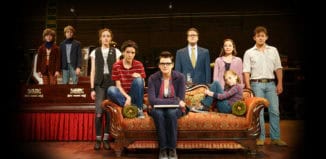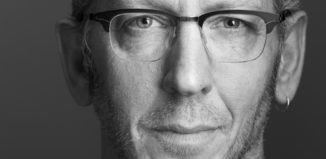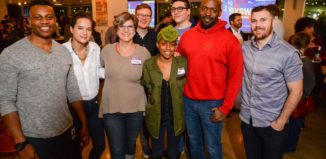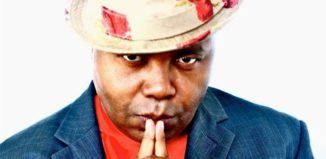The list of gay artists throughout history is long with people who dared speak their names: Oscar Wilde, Bruce Nugent, Federico Garcia Lorca, Robert Mapplethorpe, David Wojnarowicz—people throughout centuries and countries and backgrounds. Even though the world, and many inside it, tried to punish them for their art, they persisted—and created. They stayed. Each made a mark upon our world, bringing truth, no matter the consequences, which meant the risk of social degradation and ostracism.
Once you start paying attention, you start seeing the patterns, even with those who made their art but aren’t as remembered. Some were thrown to a dustbin of history, having been scandalized just because they were being who they were. Early 20th century novelist and poet Baron Jacques d’Adelswärd-Fersen became a persona non grata in the salons of Paris after he was accused of holding Black Masses featuring tableaux vivants of schoolboys. He exiled himself to the island of Capri to spend the rest of his days. Leslie Hutchinson, known as Hutch, and born in Grenada, was one of the biggest cabaret stars in the world during the 1920s and 1930s. He was a lover of Cole Porter’s, among others. It was said he had affairs with members of the British royal family, leading to the destruction of his professional career.
Since the start of the modern LGBT civil rights movement, artistic freedom has shifted in gradations the same way society has. But it becomes chicken and egg: Which drives which and which comes first—society vs. culture and art, or the other way around? There are more out artists in many fields building their craft and making their names, but as society has become more welcoming to gays—and their art—the identity has shifted. It’s as if post-Stonewall, each of these artists wants to be known beyond borders and walls and boundaries, opening up the space for appreciation by all—or at least as many people as possible.
Thanks to airplanes and the Internet, people are closer than ever. Films and documentaries explore how lives are lived, particularly gay lives, in Africa or South America. Eastern Europeans who move to Toronto. Americans who live in Berlin. Turkish men who dream of Detroit and Brooklyn. To capture the zeitgeist, these artists can be anywhere. For the first time, the Paris of the 1920s, the Harlem Renaissance, Andy Warhol’s factory, and the like, any art movement that previously was confined to one location, keeping many out, has spread all over— around the world and on the Internet, which is fast becoming a salon where emerging artists can share their work and ideas as quickly as the World Wide Web can travel.
One such space is Gegen Berlin. “Gegen,” which is German for both “against” and “around,” at first glance is just a party for everyone. But then, upon closer inspection, it’s a happening, with invites like the old art movement manifestos, where artists of various mediums come to dance, be merry, and be amid art installations and music, representing all the art and various sexualities under the sun. And that is the direction gay art is moving toward— being a place for everyone.
DEFINING MOMENTS IN THE ARTS
1.Orlando: A Biography was published by Virginia Woolf on October 11, 1928. The semi-biographical novel, about the transgender Orlando refusing
to grow old, is based in part on the life of Woolf’s lover, Vita Sackville-West.
2. Gertrude Stein published her memoirs in 1933 called The Autobiography of Alice B. Toklas. Toklas and Stein, who met in 1907, were in a committed relationship until Stein’s death in 1946.
3. Alice Walker’s 1982 epistolary novel, The Color Purple, disrupts traditional gender roles based on the crypto-lesbian and sexual relationship of its main characters, Celie and Shug, in the 1930s deep South. The book won the 1983 Pulitzer Prize for Fiction and the National Book Award for Fiction and was later adapted into a film and musical of the same name, but it only hinted at the characters’ lesbianism.
4. Ellen DeGeneres’ sitcom character, Ellen, comes out in “The Puppy Episode” on ABC on April 30, 1997, drawing 42 million viewers. It won a Primetime Emmy Award for Outstanding Writing for a Comedy Series and a Peabody Award.
5. The 1998 opera, Patience and Sarah, by Paula M. Kimper, is the first lesbian opera and the first mainstream gay-themed opera. It is based on a novel detailing real-life painter Mary Ann Willson, who lived with her companion Miss Brundage in the early 19th century in the farmlands of New York.
6. Fire!! was a literary magazine, with just one issue, published in 1926 during the Harlem Renaissance by Wallace Thurman, Zora Neale Hurston, Countee Cullen, and Langston Hughes. In it, Richard Bruce Nugent published “Smoke, Lilies, and Jade,” a short story, the first work by a black writer to depict homosexuality openly.
7. The Boys in the Band, a play by Mart Crowley, opened Off-Broadway production on April 14, 1968, running for more than 1,000 performances. The seminal work, made into a 1970 film, was the first of its kind to feature gay characters being themselves for a mainstream audience.
9. Artist Gilbert Baker designed the first rainbow flag for San Francisco Pride on June 25, 1978. The flag, now a global symbol, had eight colors, each with a symbolic meaning: hot pink: sexuality; red: life; orange: healing; yellow: sunlight; green: nature; turquoise: magic/art; blue: serenity/harmony; violet: spirit.
10. David Wojnarowicz’s 1990 “Untitled (One Day This Kid…)” is a photostat telling a quick coming of age story of a gay man. It is in the permanent collection of the Whitney Museum of American Art.





































